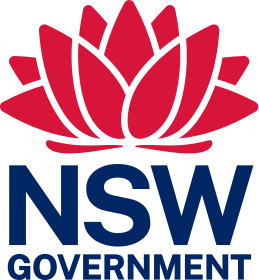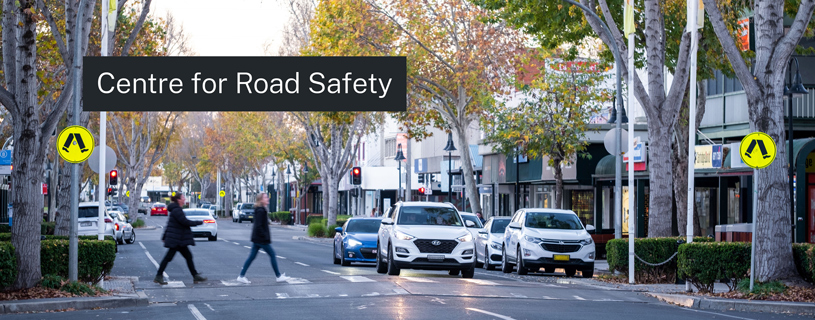
NSW AusRAP map
NSW is the first jurisdiction to fully map its State and Regional Road networks to show their safety star ratings under the Australian Road Assessment Program (AusRAP).
NSW has more than 20,000km of State Roads and 15,000km of Regional Roads. This data set doesn’t include local council-managed roads.
The data was collected from surveys over the past 10 years and will be updated regularly.
Our interactive map allows you to view star ratings for State and Regional Roads across NSW as part of AusRAP.
- NSW compares well to other Australian states and territories, with more than 71% of all road travel taken on State Roads rated 3 or more stars for safety.
- NSW is working towards the national target of 80% of all road travel in the state being taken on State Roads rated 3 or more stars by 2030. This target aims to significantly reduce road deaths and serious injuries, contributing to Australia's vision of zero road fatalities by 2050.
- In all regions of NSW, the largest category is 3 stars.
- There’s room to improve through upgrades to 1 and 2 star roads to achieve 3 star status.
About the Australian Road Assessment Program (AusRAP)
AusRAP, the Australian Road Assessment Program, is a national initiative under the global International Road Assessment Program (iRAP). AusRAP helps to improve road safety across Australia by evaluating road conditions and assigning safety ratings.
Roads are rated from 1-star (least safe) to 5-star (safest) using a method that assesses road features that affect the risk of crashing and severity of crashes that occur. These star ratings are informed by detailed data on road characteristics, traffic volumes, and safety infrastructure to create star rating maps, from which safety plans can be developed.
This system highlights high-risk road sections and helps identify where safety improvements could make the greatest impact. Typically, higher-rated roads feature enhanced safety elements such as clearer line markings, wider lanes, and safety measures like barriers and rumble strips to reduce crash risk.
AusRAP is part of a global movement through iRAP to make roads safer for everyone. Since 2021, Austroads has managed AusRAP, aligning the program with Australia’s broader commitment to creating a safer road network.
Aims of rating roads for safety
The AusRAP targets don’t require all roads in NSW to become 5-stars. The greatest benefit, in terms of the number of lives saved and serious injuries avoided per dollar invested, will most often be achieved by upgrading low star roads that carry high traffic volumes to at least 3-star safety standard, rather than bringing 4-star rated roads up to 5 stars.
In most cases, the biggest impact on road trauma comes from upgrading high-risk roads where people travel the most, resulting in reduced crash risk and trauma.
Roads score higher star ratings for safety features like wider lanes, wider shoulders, crash barriers, divided dual carriageways, reflective markings and rumble strips. A 5-star road has all these features, reflecting how the Safe System approach has become part of modern road design that prevents crashes and reduces their severity.
Lower star ratings don’t indicate roads are unsafe, but they provide an analysis of how well a road’s design helps prevent crashes or reduce their severity. These ratings help prioritise where safety improvements will have the greatest impact.
Not all roads need to be 5-stars, and not all 1-star roads need to be upgraded in order to be considered fit for purpose.
For example, going from 1 to 3 stars requires roadside barriers to protect road users from impacting with power poles or trees, and increased shoulder width to allow more recovery time for drivers.
How AusRAP star ratings are determined and used
AusRAP star ratings provide valuable insights that enable road authorities to make informed decisions on where to invest in safety improvements. Ratings are based on factors that influence crash likelihood and severity, such as lane width, roadside hazards, conditions for pedestrians and cyclists, speed limits, and road curves.
Using this information, authorities can strategically plan safety upgrades across road networks, contributing to safer journeys for all road users. Key factors and features assessed in AusRAP’s star rating process include:
How roads are rated
AusRAP follows iRAP’s methodology to assess road safety by collecting data on up to 78 road features for every 100-metre section. These features include lane width, speed limits, roadside hazards, and the presence of pedestrian and cyclist pathways.
The star ratings are assigned by calculating safety rating scores for each type of road user—vehicle occupants, motorcyclists, cyclists, and pedestrians. In the current results, only vehicle occupant star ratings are shown. Roads with higher ratings tend to have additional safety features to protect vulnerable users.
Example of a 1 Star rated road:
- Pedestrians - no sidewalk, no safe crossing, 60km/h traffic speed
- Bicycle riders - no cycle path, no safe crossings, poor road surface, 70km/h traffic speed
- Motor vehicles - undivided road with no centreline, trees close to road, winding alignment, 100km/h traffic speed.
Example of a 5 Star rated road:
- Pedestrians - pedestrian sidewalk, signalised crossing with refuge, street lighting, 40km/h traffic speed
- Bicycle riders - off-road dedicated cycling facility, raised platform crossing of major roads, adequate street lighting
- Motor vehicles - safety barrier separating oncoming vehicles and protecting roadside hazards, straight alignment, 100km/h traffic speed.
AusRAP mission and goal
AusRAP’s mission is to eliminate high-risk roads for all road users in Australia. By 2025, Australian states and territories aim to publish AusRAP star ratings for all arterial roads. By 2030, the goal is for at least 80% of travel to take place on roads with a 3-star rating or higher.
As a member of Austroads, Transport for NSW, along with other Australian and New Zealand transport agencies, has endorsed the AusRAP Strategy and Business Plan, supporting these national targets.
AusRAP’s priorities include fostering a culture of safety and continuous improvement, regular program reviews and updates, and coordinated communication. AusRAP is a complex system and is best suited for use by road authorities with appropriate technical expertise. Austroads provide a range of tools and guidance to support local governments in optimising road safety investments to reduce road trauma across Australian roads.
Transport for NSW programs
Road safety infrastructure programs that are primarily responsible for improving the safety performance of the NSW road network are invested and delivered via the NSW Government Towards Zero Safer Roads Program and Australian Government Road Safety Program.
The Towards Zero Safer Roads Program is part of NSW’s broader road safety strategy to achieve zero fatalities and serious injuries on the roads. This initiative focuses on upgrading high-risk road areas, installing proven safety features such as barriers, rumble strips, and improved signage, and making infrastructure changes to protect all road users, including pedestrians, cyclists, and motorists. Through targeted safety improvements, Towards Zero aims to create safer journeys and reduce road trauma across NSW.
The Australian Government Road Safety Program is a collaborative effort between the Australian and NSW Governments, investing $518 million to improve safety and reduce crashes on NSW roads. Launched in early 2024, the program allocates funds to councils across NSW, focusing on delivering lifesaving road safety treatments on remote, regional, and urban roads. It aims to reduce fatal injuries by 50% and serious injuries by 30% on NSW roads by 2030, aligning with national road safety strategies.
Case studies
Find out how we use AusRAP to make NSW roads safer:
FAQs
What is AusRAP?
AusRAP stands for the Australian Road Assessment Program. It evaluates the safety of roads and assigns star ratings based on their safety performance, with 1 star indicating the least safest and 5 stars the highest level of safety.
Why are AusRAP star ratings important?
AusRAP star ratings provide a clear and objective measure of road safety. They help identify high-risk roads that need safety improvements, guiding investments to where they can have the most significant impact to reduce crashes and save lives.
How do star ratings influence road safety investments?
Star ratings highlight the safety performance of roads, allowing authorities to prioritise funding for upgrades on the most high-risk roads. This ensures that limited resources are used effectively to enhance road safety for the communities of NSW.
What are the benefits of investing in high-star rated roads?
Investing in high-star rated roads reduces the likelihood/severity of crashes, injuries and fatalities. It also leads to long-term economic benefits by lowering healthcare costs and improving traffic flow and efficiency.
What is the goal of the AusRAP star rating system?
The goal is to ensure that at least 80% of travel occurs on roads with a 3-star rating or higher by 2030. This target aims to significantly reduce road deaths and serious injuries, contributing to Australia's vision of zero road fatalities by 2050.
How are star ratings determined?
Star ratings are determined through detailed assessments of road features, such as lane width, shoulder design, and the presence of safety barriers. These factors are analysed to predict the likelihood of crashes and their potential severity.
Who uses AusRAP star ratings?
Government agencies, road authorities, and local councils use AusRAP star ratings to plan and prioritise road safety improvements. The ratings are also valuable to inform the public about the safety of the roads they use.
How does the public benefit from AusRAP star ratings?
The public benefits from safer roads, reduced crash rates, and improved travel conditions. Awareness of star ratings can also encourage safer driving behaviours and support advocacy for road safety improvements.
What role do stakeholders play in AusRAP?
Stakeholders, including government bodies, road safety organisations and local communities, collaborate to collect data, analyse road conditions, and implement safety measures based on AusRAP star ratings.
How can individuals support road safety initiatives?
Individuals can support road safety initiatives by staying informed about the star ratings of roads they travel on, advocating for improvements in high-risk areas and practising safe driving habits.
More information
Saving Lives on Country Roads Initiative
By installing key treatments on country roads, we target the crash types commonly related to lane departure and driver fatigue.
Safe and Liveable Urban Communities Initiative
Find out how we improve safety in urban areas with infrastructure upgrades for pedestrians and bicycle riders, and address serious injury crashes.
Road Safety Program 2024/25-2026/27
The Australian and NSW Governments are investing $518 million to improve safety and reduce crashes on NSW roads.


